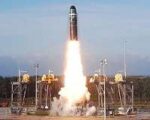The U.S. Air Force’s highly classified Joint Advanced Tactical Missile (JATM) program—intended to replace the venerable AIM-120 AMRAAM—is facing delays due to ongoing Congressional budget dysfunction. Lawmakers have confirmed that the lack of a full-year defense appropriation has disrupted production and testing schedules for this next-generation air-to-air missile critical to future air dominance concepts like NGAD.
Shutdown and Continuing Resolutions Stall Critical Programs
According to recent statements from members of Congress and Air Force officials, the JATM program has been directly impacted by the current budgetary impasse in Washington. The U.S. Department of Defense is operating under a continuing resolution (CR), which freezes funding at previous fiscal year levels and prohibits new start programs or significant ramp-ups in production.
Rep. Rob Wittman (R-Va.), chair of the House Armed Services tactical air and land forces subcommittee, stated during a Feb. 14 hearing that “the continuing resolution has already delayed” the JATM effort. He emphasized that such delays are not merely bureaucratic but have “real-world consequences” for maintaining U.S. air superiority against pacing threats like China.
The CR is currently set to expire on March 8 for defense-related spending unless Congress passes a full-year appropriations bill or another extension. The uncertainty has frozen progress on multiple modernization efforts including JATM, Next Generation Air Dominance (NGAD), Collaborative Combat Aircraft (CCA), and other advanced munitions programs.
What Is JATM? A Highly Classified Successor to AMRAAM
The Joint Advanced Tactical Missile—designated AIM-260—is being developed by Lockheed Martin as a long-range beyond visual range (BVR) air-to-air missile intended to counter advanced threats such as China’s PL-15 missile fielded on its J-20 stealth fighters.
While most details remain classified, open-source information suggests that JATM will exceed the range of Raytheon’s AIM-120D AMRAAM (~160 km) while fitting within the same weapons bay constraints of fifth-generation fighters like the F-22 Raptor and F-35 Lightning II. This allows for seamless integration without compromising stealth profiles.
The missile is expected to feature an advanced propulsion system—possibly dual-pulse solid rocket or even variable flow ducted rocket—and a sophisticated seeker capable of operating in contested electromagnetic environments with electronic counter-countermeasures (ECCM). Integration with Link 16 or future datalinks will likely enable midcourse updates from offboard sensors.
Operational Urgency Driven by Chinese Capability Advances
The urgency behind JATM stems from growing concerns over peer adversaries’ long-range air-to-air capabilities—especially China’s PL-15 missile reportedly capable of ranges exceeding 200 km with active radar guidance and datalink support.
U.S. military planners view this as a direct challenge to American airborne platforms operating in contested Indo-Pacific environments where standoff engagement ranges are crucial for survival against integrated air defenses and numerically superior adversary aircraft.
JATM is envisioned not just as an incremental improvement but as a leap-ahead capability underpinning future concepts like NGAD—a family-of-systems approach combining manned sixth-generation fighters with autonomous Collaborative Combat Aircraft (CCA) drones armed with weapons like JATM.
Production Ramp-Up Blocked by Budget Constraints
The Air Force had planned an aggressive ramp-up in JATM production starting in FY24 following low-rate initial production phases conducted under classified rapid prototyping authorities. However, without full-year appropriations authority, Pentagon acquisition officials cannot increase production rates or initiate follow-on development contracts necessary for full operational capability fielding by mid-decade.
This delay risks cascading effects across multiple programs reliant on synchronized capability delivery—including sensor fusion upgrades for F-22/F-35 platforms and CCA payload integration timelines aligned with NGAD milestones targeted around 2030.
Lt Gen Richard G. Moore Jr., Air Force deputy chief of staff for plans and programs, warned lawmakers during recent testimony that “we can’t ramp up production [of JATM] under a CR,” highlighting how even classified black-budget programs are vulnerable to Congressional gridlock despite their strategic priority status within DoD planning documents such as the FY24 Unfunded Priorities List.
Lack of Transparency Complicates Oversight
The highly classified nature of JATM complicates both public understanding and Congressional oversight. Unlike other major weapon systems tracked via Selected Acquisition Reports or GAO audits, few official details about cost per unit, testing milestones, or IOC/FOC timelines are available publicly.
This opacity has led some lawmakers—including Rep. Wittman—to call for greater transparency regarding how CR-induced delays affect high-priority modernization efforts embedded within black-budget portfolios managed by Special Access Programs (SAPs).
While operational security concerns justify classification of technical specifics such as seeker type or propulsion method, broader programmatic impacts—such as missed test windows or delayed procurement lots—could be shared more openly without compromising sensitive data.
Outlook: Appropriations Deal Needed to Avoid Strategic Setbacks
If Congress fails again to pass a full-year defense appropriations bill before March deadlines lapse into another CR—or worse yet—a partial government shutdown affecting DoD civilians and contractors could further derail progress on time-sensitive programs like JATM.
- AIM-260 fielding was originally targeted for IOC around FY2025–26, aligning with early NGAD spiral deployments;
- Delays now threaten interoperability timelines between manned fighters and CCA drones relying on common weapons architectures;
- Synchronized upgrades across platforms may be misaligned, reducing combat effectiveness in near-peer scenarios;
- Sustainment planning could be disrupted, affecting long-term logistics chains dependent on early batch data;
- Adversaries may exploit perceived gaps, accelerating their own countermeasures development cycles based on delayed U.S. fielding patterns.
A bipartisan push appears underway among key House Armed Services Committee members urging leadership to prioritize defense appropriations before March 8th—but whether political gridlock can be overcome remains uncertain amid broader fiscal debates over domestic spending caps tied to debt ceiling negotiations earlier last year.
Conclusion: Strategic Programs Held Hostage by Political Dysfunction
The delay affecting the Joint Advanced Tactical Missile underscores how even top-tier national security priorities can be undermined by legislative inertia. As great power competition intensifies across multiple domains—from hypersonics to AI-enabled autonomy—the inability to execute planned ramp-ups in critical technologies like AIM-260 risks ceding advantage at precisely the moment when deterrence depends most on credible capability delivery timelines.










